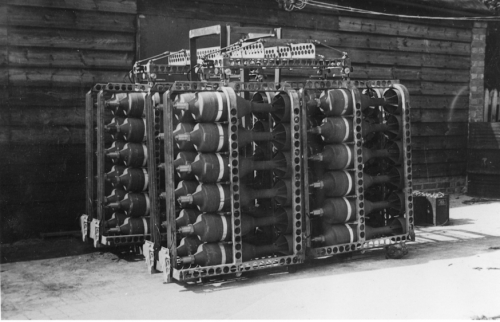DWG
ACCESS: Top Secret
- Joined
- 11 February 2007
- Messages
- 1,754
- Reaction score
- 2,283
(This is one of those topics that seems to fall between boards, Missile Projects comes closest, AFAICS)
I recently came across the USN's 1946 'British Explosive Ordnance', which turns out to be one of the most fascinating things I've read in a while - there's a staggering number of UK cluster weapons, for instance. There's a copy online here http://www.lexpev.nl/downloads/britishexplosiveordnance1946.pdf , and similar documents for the other WWII nations.
One project that particularly caught my eye is the 35lb AS Bomb Mk I/II in the Obsolete Weapons Chapter. At first glance this seems to be a Hedgehog bomblet, and, while I've seen air-delivered Hedgehog proposed in an alternate history project, I'd never come across any evidence that it was tried for real. But then it struck me that the weight doesn't fit. Most references I've seen for Hedgehog give the weight as 65lb, with a 35lb warhead, and even assuming a drop in weight due to not needing the propellant charge, you aren't going to get the structural weight down to zero, and warhead weight of the 35lb AS is actually given as 16lbs of RDX/TNT 60/40. So does this mean there was a predecessor project to Hedgehog using a smaller bomblet? Note that the 35lb AS Bomb Mk II is specifically identified as a shipboard-fired version.
Googling around turned up a few more pages, mostly frustrating references to bits of the National Archives that haven't been digitised as yet - such as trials of an 8 round dispenser intended for Halifax, but also an IWM page on the weapon http://www.iwm.org.uk/collections/item/object/30023796 which includes the fascinating detail that operational trials on Hudsons in early 1943 may have resulted in two kills. http://uboat.net/boats/u558.htm lists an attack on U-558 by a Liberator dropping 24 weapons, and having a hang-up on a second attempt, while http://uboat.net/boats/u628.htm is a kill, but with the coup de grace from airborne depth charges after an initial attack with 35lb AS Mk I - this attack on 3 Jul 43 is stated to be the first operational use, again from Liberator.
Really interested to hear if anyone can clarify the relationship between 35lb AS Bomb Mk I/II and Hedgehog.
I recently came across the USN's 1946 'British Explosive Ordnance', which turns out to be one of the most fascinating things I've read in a while - there's a staggering number of UK cluster weapons, for instance. There's a copy online here http://www.lexpev.nl/downloads/britishexplosiveordnance1946.pdf , and similar documents for the other WWII nations.
One project that particularly caught my eye is the 35lb AS Bomb Mk I/II in the Obsolete Weapons Chapter. At first glance this seems to be a Hedgehog bomblet, and, while I've seen air-delivered Hedgehog proposed in an alternate history project, I'd never come across any evidence that it was tried for real. But then it struck me that the weight doesn't fit. Most references I've seen for Hedgehog give the weight as 65lb, with a 35lb warhead, and even assuming a drop in weight due to not needing the propellant charge, you aren't going to get the structural weight down to zero, and warhead weight of the 35lb AS is actually given as 16lbs of RDX/TNT 60/40. So does this mean there was a predecessor project to Hedgehog using a smaller bomblet? Note that the 35lb AS Bomb Mk II is specifically identified as a shipboard-fired version.
Googling around turned up a few more pages, mostly frustrating references to bits of the National Archives that haven't been digitised as yet - such as trials of an 8 round dispenser intended for Halifax, but also an IWM page on the weapon http://www.iwm.org.uk/collections/item/object/30023796 which includes the fascinating detail that operational trials on Hudsons in early 1943 may have resulted in two kills. http://uboat.net/boats/u558.htm lists an attack on U-558 by a Liberator dropping 24 weapons, and having a hang-up on a second attempt, while http://uboat.net/boats/u628.htm is a kill, but with the coup de grace from airborne depth charges after an initial attack with 35lb AS Mk I - this attack on 3 Jul 43 is stated to be the first operational use, again from Liberator.
Really interested to hear if anyone can clarify the relationship between 35lb AS Bomb Mk I/II and Hedgehog.

